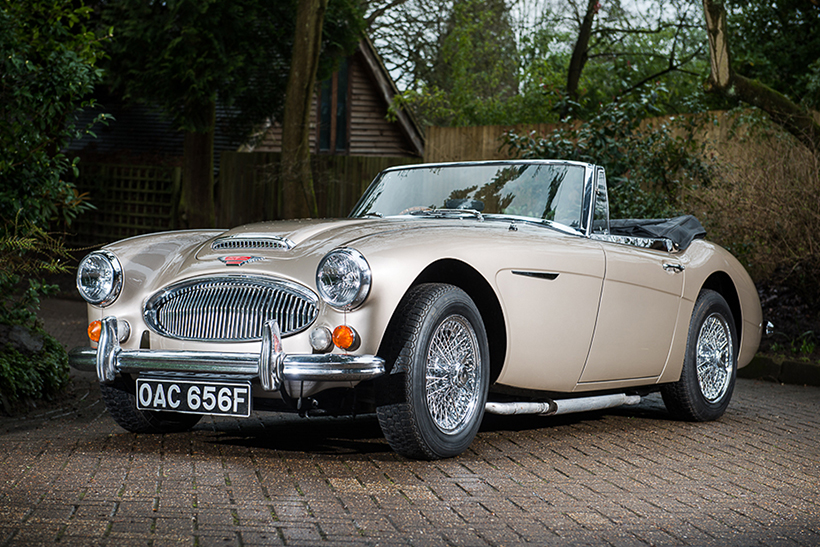The Austin-Healey 3000 is one of the most revered sports cars around; a real he-man’s machine that requires a good degree of dedication to drive to its full potential. Here are some snippets you might not have known about it.
1. BIG – BUT NOT THAT BIG
The Austin-Healey 3000 – in fact, its predecessors too – is often referred to as the ‘Big Healey’ and although it’s no lightweight, it actually isn’t a very large car. In fact, it is just a few inches longer and wider than, for example, the Triumph TR range, although it feels significantly more bulky. The nickname came through comparison with the diminutive Austin- Healey Sprite and was coined to set it apart from the ‘Frogeye’.
2. SORRY, OFFICER
Donald Healey was addicted to speed and often tested his own creations on public roads. It was in one of his earlier cars – the Elliott – that he drove past a police officer in Oxford, who gave chase. The constable couldn’t even stay with him, let alone catch up. Later, Healey wrote a letter to the chief constable, apologising for his misdemeanour and suggesting that, perhaps, the force might buy some of his cars to make pursuing criminals easier. The chief constable declined the offer, but was impressed and bought one. Folklore? Maybe. We prefer to regard it as a true story.
3. THE NAME GAME
The name Austin-Healey 3000 has become almost a generic title for any of the Big Healeys, but the model’s progression is far more complicated. Leaving aside the special competition editions, production went like this: Austin-Healey 100 BN1 (three-speed) 1952-1955, BN2 (four-speed)
1955-1956, Austin-Healey 100/6 BN4 (two-plus- two) 1956-1959, BN6 (two-seater) 1958-1959, MkI Austin-Healey 3000 BN7 (two-seater) 1959-1961, BT7 (two-plus-two) 1959-1961, MkII 3000 BN7 (two-seater) 1961-1962, BT7 (two-plus-two) 1961-1962, BJ7 (two-plus-two) 1962-1963 and MkIII 3000 BJ8 Phase 1 (two- plus-two) 1964, plus the BJ8 Phase 2 (two- plus-two) 1964-1967. In all, nearly 79,000 Big Healeys were made and the 3000 accounted for 60 per cent of those.
4. YOUNGER THE BETTER?
In classic circles, it is almost always the case that the earlier the model, the more desirable it is. The main reason for that is that cars generally take a backward step as each successive model is produced. They become portlier, slower and lose some of their original charm. Good (if that is the correct word) examples are the Series 3 V12 Jaguar E-type, compared with the first 3.8-litre roadster, rubber-bumper MGBs and Midgets and the 240 and 340 Jaguars. The Healey 3000 bucks the trend and each model was an improvement. Unless you are absolutely fixated on one particular type, it’s beyond argument that the MkIII 3000 is the pick of the bunch. It was the most powerful, fastest and best- equipped Healey of the lot, with luxuries (for the time) including a walnut-veneer dash, wind- up windows and servo-assisted disc brakes. However, it must be conceded that interior trim in the final models was downgraded to Ambla (the same fate befell the aforementioned 240 and 340 Jaguars) while leather became
an optional extra.
5. MARK OUR WORDS
No car manufacturer has ever built a MkI version of any model, because to do so would tell the motoring public that a MkII was to follow and buyers would wait for the later – and, presumably, better – version to be launched. The first Austin-Healey 3000 was built until March 1961 and designated the BN7 (two-seater) and BT7 (two-plus-two). It was referred to as the ‘Mark 1’ when its successor was launched, incidentally, costing £1362 in 1961, which represented good value for money.
6. TWO’S COMPANY, THREE’S A CROWD
The Healey 3000 used a C Series engine taken out from 2639cc to 2912cc and its name came from the engine capacity, rather than its ability to crack the ton (hence, the ‘100’ in the names of its predecessors). In an effort to coax a bit more power from the motor of the MkII, triple SU HS8 carburettors were fitted. They did provide a few extra horses, but proved so difficult to keep in tune that the factory dropped the idea after a year and reverted to a pair of HS6 carbs, which were within the capabilities of most home mechanics.
7. KNOWLEDGE IS POWER
The final Healey 3000 had 150bhp at its disposal which, in its day, was a lot of power. But it obtained that thrust as much from engine size as tuning. Put it this way, the motor generated about 50bhp-pet-litre, which in today’s terms, is not much. The MkII was good for 124bhp and that figure was comfortably bettered, in bhp-per-litre terms, by the Austin Allegro’s 998cc A-plus engine, which provided 44bhp. But let’s be fair, we are talking about a gap many years, during which technology improved vastly – and anyway, given the choice of a Big Healey or an Allegro, which one would you choose?





